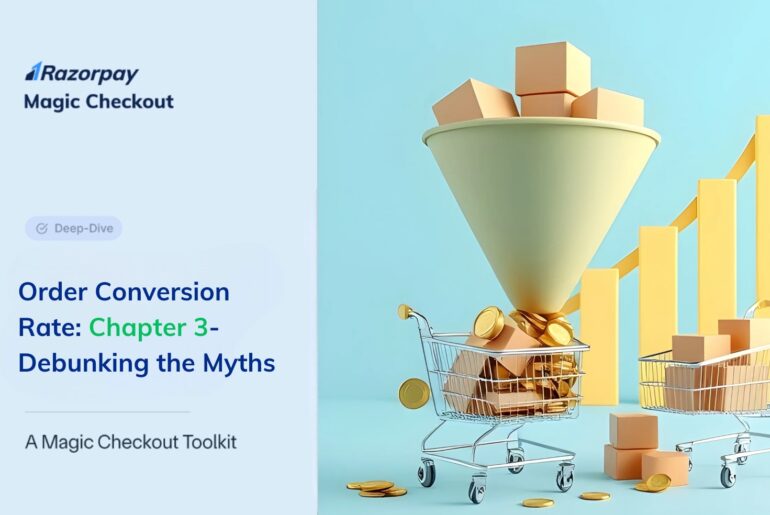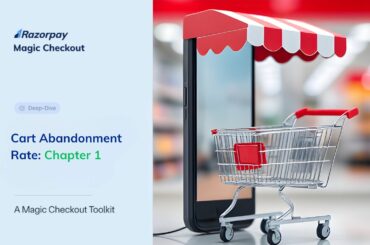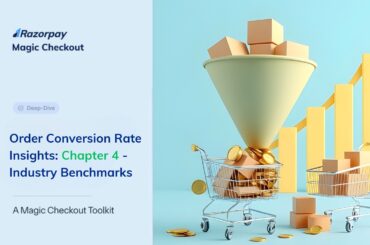Order Conversion Rate (OCR) is a fundamental metric for e-commerce businesses aiming to optimize their customer journey and improve overall performance. However, many myths cloud the true understanding of this key indicator. These misconceptions can prevent businesses from unlocking their full potential to drive meaningful conversions. In Chapter 3 of our Order Conversion Rate blog series, we’ll address some of the most common misunderstandings about order conversion rates and explain why a more nuanced approach is essential for sustained growth.
Table of Contents
Myth 1: High Traffic Equals High Conversions
Reality: Many businesses assume that increasing website traffic will automatically boost order conversions. However, if the traffic isn’t targeted, the order conversion rate may remain stagnant.
Solution: Focus on attracting high-intent visitors by leveraging channels like organic search and retargeting campaigns. Use audience segmentation and personalization to align your offerings with user intent.
Data Insight: According to HubSpot, personalized CTAs convert 202% better than generic ones.
Myth 2: A Lower Price Always Increases Order Conversion Rates
Reality: While competitive pricing is important, it’s not the sole factor influencing purchase decisions. Customers often prioritize quality, brand trust, and overall value over price alone.
Solution: Emphasize your unique value proposition (UVP), build trust through testimonials, and showcase quality assurance.
Data Insight: Research by Baymard Institute shows that 48% of cart abandonments occur due to extra costs, such as shipping.
Myth 3: More Features Lead to Higher Order Conversions
Reality: Overloading your site or product with features can overwhelm users and dilute the core value proposition.
Solution: Prioritize usability and focus on features that address key pain points for your target audience. Use A/B testing to evaluate which features resonate most.
Example with Data: Crazy Egg simplified its landing page, focusing on just one key feature per fold. This streamlined approach resulted in a 64% increase in sign-ups.
Myth 4: Order Conversion Rates Are All About the Checkout Page
Reality: While the checkout page is crucial, user experience across the entire buyer journey—including homepage design, product pages, and site speed—plays a significant role.
Solution: Optimize all touchpoints by improving navigation, adding detailed product descriptions, and reducing load times.
Data Insight: Google reports that a one-second delay in mobile page load time can reduce conversions by up to 20%.
Myth 5: Offering Discounts Always Converts More Customers
Reality: Overusing discounts can harm your brand value and train customers to wait for price drops.
Solution: Use discounts strategically—introduce loyalty programs, exclusive sales, or bundled offers to drive urgency without devaluing your products.
Data Insight: A study by RetailMeNot found that 68% of customers say exclusive discounts for returning shoppers make them more likely to repurchase.
Myth 6: Only New Visitors Drive Conversions
Reality: Repeat visitors are often more likely to convert due to familiarity with your brand and offerings.
Solution: Nurture relationships with returning users through email campaigns, remarketing ads, and personalized experiences.
Data Insight: Adobe found that repeat customers are nine times more likely to convert compared to first-time visitors.
Myth 7: Mobile Optimization is Optional
Reality: With mobile commerce accounting for a significant portion of online sales, an unoptimized mobile experience can severely impact conversions.
Solution: Implement responsive design, optimize for touch navigation, and streamline mobile checkout processes.
Data Insight: According to Statista, mobile commerce made up 60% of all e-commerce in 2023.
Myth 8: A/B Testing is a One-Time Activity
Reality: User preferences and market trends evolve constantly, making ongoing testing essential for sustained improvement.
Solution: Regularly test key elements like CTAs, headlines, and visuals. Use insights to refine strategies over time.
Example: An e-commerce site ran monthly A/B tests on CTA button colors and wording. Over six months, these iterations contributed to a cumulative 15% rise in conversions.
Myth 9: Pop-Ups Always Hurt Conversions
Reality: Properly timed, non-intrusive pop-ups can boost conversions by engaging users at critical moments.
Solution: Use exit-intent pop-ups or time-based offers strategically to enhance user experience.
Data Insight: Sumo found that the average order conversion rate for pop-ups is 3.09%, with the top 10% achieving over 9%. A food delivery app introduced a pop-up offering 10% off for first-time users and achieved an 8% order conversion rate.
Myth 10: Lower Bounce Rates Guarantee Higher Conversions
Reality: A low bounce rate may indicate user engagement but doesn’t always correlate with higher conversions.
Solution: Focus on the quality of interactions by guiding users effectively toward conversion points.
Example: An electronics retailer noticed high engagement on their blog but low conversions. Adding product links and CTAs to blog posts improved conversions by 12%.
Myth 11: Order Conversion Rate Benchmarks Are Universal
Reality: Conversion benchmarks differ significantly across industries, product types, and regions. Using generic benchmarks may lead to unrealistic expectations.
Solution: Set your benchmarks by analyzing historical data, market conditions, and specific audience behavior.
Data Insight: Shopify reports average order conversion rates of 3.48% for the health and beauty industry, but this figure varies widely depending on geography and marketing strategy.
Myth 12: One-Click Checkout Isn’t Necessary for Higher Order Conversion Rates
Reality: Some believe that adding a one-click checkout option isn’t crucial for improving order conversion rates. However, simplifying the checkout process is one of the most effective ways to reduce friction and increase conversions.
Solution: One-click checkout significantly streamlines the purchasing process, eliminating the need for customers to re-enter their details each time. This not only speeds up the transaction but also minimizes cart abandonment, ultimately boosting conversion rates.
Take Magic Checkout, for example. It makes the checkout process 5x faster by prefilling important details like contact, payment, and shipping information, drastically reducing checkout time. Additionally, it displays multiple payment methods, including COD, and presents the most relevant coupons and discounts, ensuring a smooth and tailored experience for every customer.
Data Insight: A study by Baymard Institute found that 21% of online shoppers abandon their cart due to a long or complicated checkout process. Implementing one-click checkout has been shown to increase conversions by up to 15%, especially for repeat customers.
Conclusion: Debunking Myths to Improve Your Order Conversion Rate
By debunking these myths, businesses can approach order conversion rate optimization with a clearer, more informed perspective. Understanding the realities behind these misconceptions allows you to focus your efforts on strategies that genuinely drive results, ensuring a seamless and rewarding experience for your customers.
In the next chapter of our Order Conversion Rate blog series, “Measuring and Analyzing Your Order Conversion Rate for Continuous Improvement,” we’ll dive into actionable steps to evaluate your conversion data. You’ll learn how to identify trends, use key analytics tools, and make data-driven decisions to sustain and enhance your e-commerce performance.
More Blogs on Order Conversion Rate:
Chapter 1: Order Conversion Rate 101: What It Is and Why It Matters
Chapter 2: How to Improve Order Conversion Rate: Best Practices and Strategies




